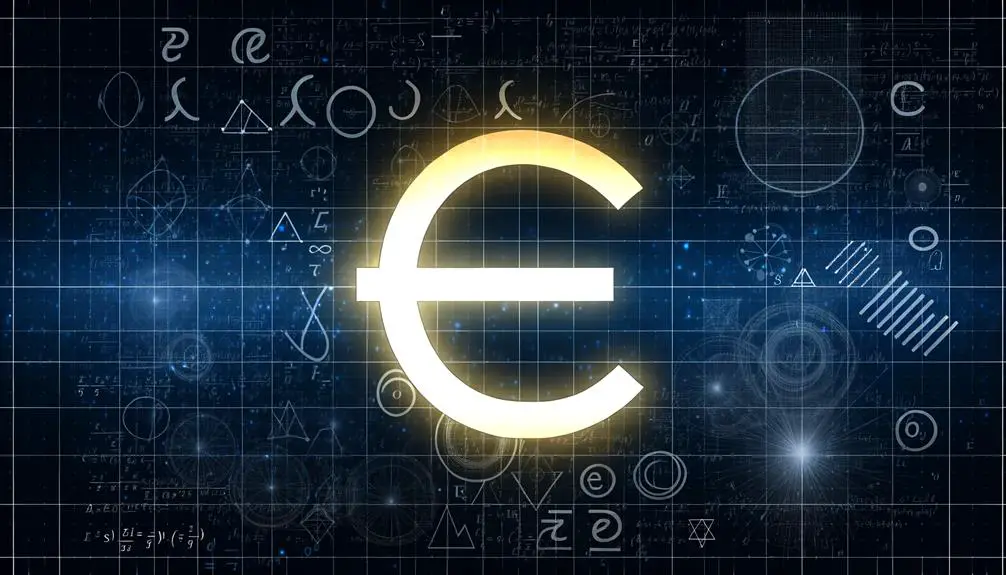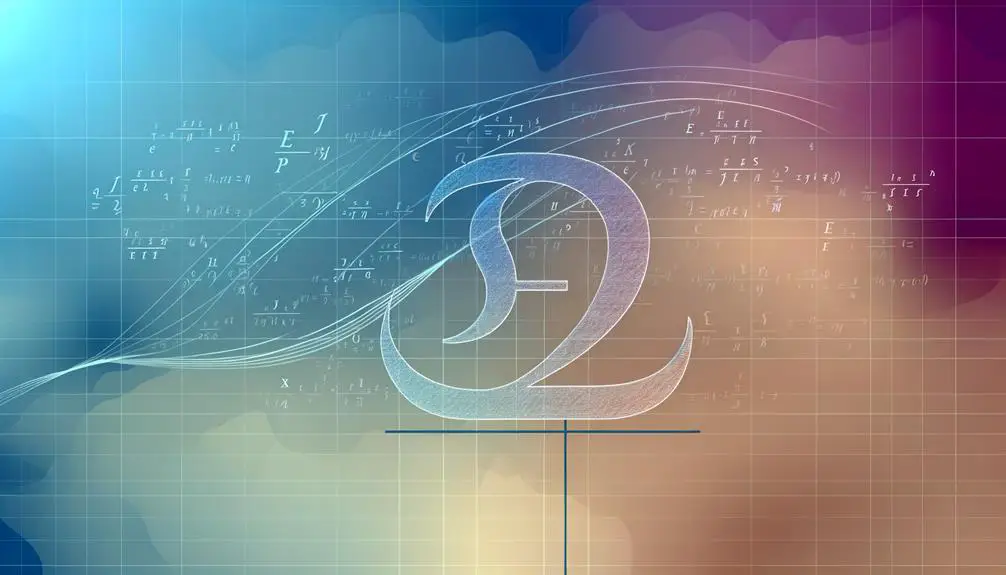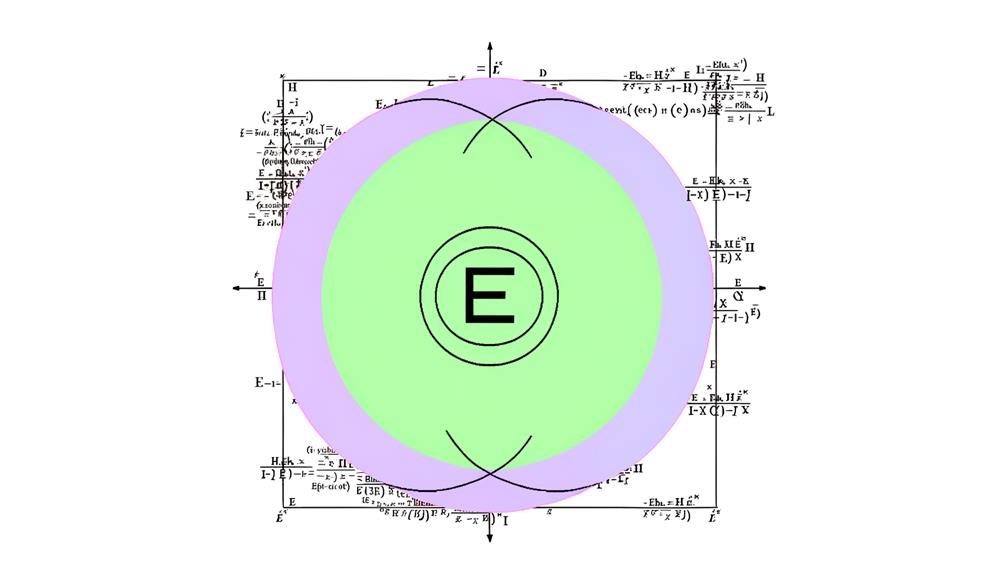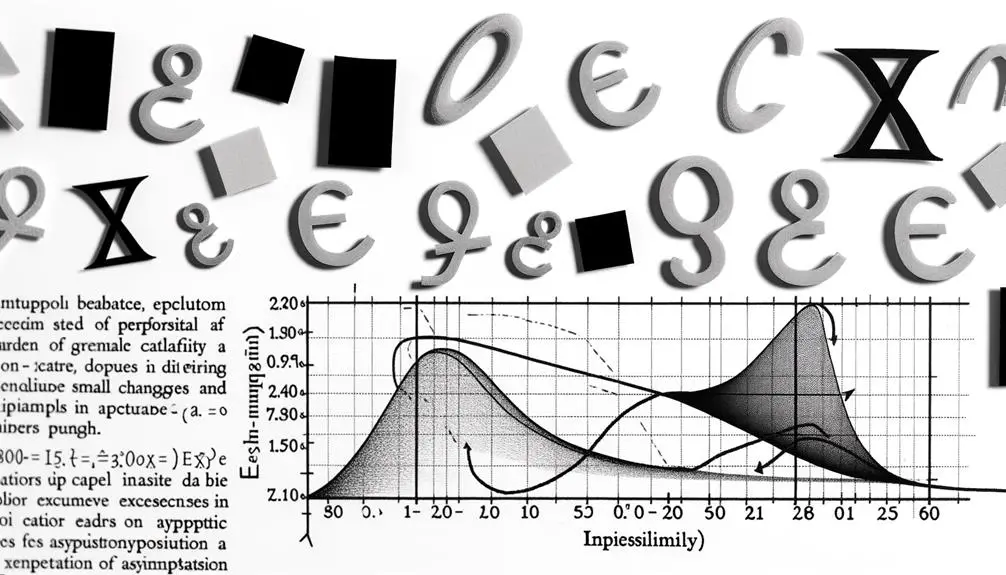What Is the Meaning of the Epsilon Symbol in Math?
The epsilon (\(\epsilon\)) symbol in mathematics represents a small positive quantity and is essential in various areas such as calculus, limits, and error margins. It is vital for defining limits through the epsilon-delta framework, ensuring precise analysis of function behavior at specific points.
In continuity and convergence, epsilon defines acceptable deviation closeness, preserving the function's integrity. Additionally, in set theory, it denotes membership and relationships between elements.
Epsilon also quantifies error margins in numerical analysis and statistical inference. To grasp the subtleties and applications of epsilon in more depth, further details await.

Key Takeaways
- Epsilon (ε) represents a small positive quantity in calculus, crucial for defining limits and continuity.
- In the epsilon-delta definition of limits, epsilon ensures the function value's closeness to the limit.
- Epsilon is fundamental in expressing error margins and precision in numerical analysis and iterative algorithms.
- In set theory, epsilon denotes membership and helps articulate set inclusion relationships.
- Epsilon is central to formalizing convergence, expressing how closely sequences or functions approach their limits.
Epsilon in Calculus

In calculus, the epsilon (ε) symbol is primarily used to denote a small positive quantity that represents an arbitrarily small tolerance or error margin. This symbol is integral in expressing the precision required for various mathematical concepts.
For example, when analyzing the behavior of functions, ε is employed to establish bounds within which certain properties hold. It is critical in ensuring that definitions and theorems are rigorously formulated.
The presence of ε allows mathematicians to articulate concepts such as continuity and differentiability with exactitude. By setting ε to be as small as needed, one can demonstrate how closely certain values can approximate others, thereby ensuring the robustness of mathematical proofs and arguments.
Epsilon and Limits
Within the context of limits, the epsilon (ε) symbol is essential for formally defining the limit of a function as it approaches a specific point.
Specifically, ε is utilized in the ε-δ (epsilon-delta) definition of a limit, which is a fundamental concept in mathematical analysis.
According to this definition, for any ε > 0, there exists a δ > 0 such that if the distance between x and a given point c is less than δ, then the distance between the function value f(x) and the limit L is less than ε.
This rigorous approach guarantees that as x gets arbitrarily close to c, f(x) gets arbitrarily close to L, thereby formally capturing the intuitive notion of a limit.
Role in Continuity

Understanding the epsilon (ε) symbol's role extends beyond limits to its pivotal function in defining the continuity of a function. For a function \( f(x) \) to be continuous at a point \( a \), for every \( \epsilon > 0 \), there must exist a \( \delta > 0 \) such that \( |x – a| < \delta \) implies \( |f(x) – f(a)| < \epsilon \). This formal definition guarantees that small changes in input produce small changes in output, preserving function behavior.
| Concept | Symbol | Meaning | ||||
|---|---|---|---|---|---|---|
| Continuity | \( \epsilon \) | Desired closeness of \( f(x) \) to \( f(a) \) | ||||
| Input Change | \( \delta \) | Allowed deviation in \( x \) from \( a \) | ||||
| Condition | \( | x – a | < \delta \) | Ensures \( | f(x) – f(a) | < \epsilon \) |
This table elucidates the precision required in continuity analysis.
Epsilon in Convergence
The epsilon symbol (ε) is integral to the formal definition of convergence in mathematical analysis, particularly in the context of limits. It plays a pivotal role in the epsilon-delta criteria, which rigorously defines the behavior of functions as they approach specific points.
Understanding this concept is essential for grasping the foundational principles of calculus and real analysis.
Definition of Epsilon
Epsilon, denoted by the Greek letter ε, represents an arbitrarily small positive quantity used to define the concept of convergence in mathematical analysis.
In this instance, ε is utilized to express how closely a sequence or function approaches a specific value, known as the limit, as its domain progresses.
The precise definition of convergence involves ensuring that for every ε > 0, there exists an index or a point beyond which the difference between the sequence or function value and the limit is less than ε.
This formalism enables mathematicians to rigorously establish the behavior of sequences and functions, facilitating a deeper understanding of continuity, differentiability, and integrability within the context of mathematical analysis.
Role in Limits
In the context of limits, the epsilon (\(\varepsilon\)) criterion provides a rigorous method for defining when a sequence or function converges to a given limit. Specifically, a sequence \(a_n\) converges to a limit \(L\) if, for every \(\varepsilon > 0\), there exists an integer \(N\) such that for all \(n \geq N\), the inequality \(|a_n – L| < \varepsilon\) holds. This formalism guarantees that the terms of the sequence get arbitrarily close to \(L\) as \(n\) increases. Similarly, for functions, convergence to a limit \(L\) at a point \(c\) requires that for every \(\varepsilon > 0\), there exists a \(\delta > 0\) such that \(|f(x) – L| < \varepsilon\) when \(0 < |x – c| < \delta\).
Epsilon-Delta Criteria
To rigorously define the concept of a function's limit at a point, the epsilon-delta criteria establish that for every \(\varepsilon > 0\), there must exist a \(\delta > 0\) such that if \(0 < |x – c| < \delta\), then \(|f(x) – L| < \varepsilon\). This framework guarantees that the function \(f(x)\) approaches the limit \(L\) as \(x\) approaches \(c\), within a specified tolerance \(\varepsilon\). The criteria form the cornerstone of mathematical analysis, providing a formal definition that underpins continuity, differentiability, and integrability. By quantifying the proximity between \(x\) and \(c\) and the corresponding functional values, the epsilon-delta approach precisely captures the intuitive notion of limits and convergence.
Set Theory Usage

In set theory, the epsilon symbol (ε) is pivotal for denoting membership, signifying that an element belongs to a particular set.
This notation is essential for expressing set inclusion, where specific elements are identified as members of distinct sets.
Consequently, the epsilon symbol facilitates precise communication regarding the composition and relationships of sets within mathematical discourse.
Membership Indication Symbol
The epsilon symbol (ε) is frequently employed in set theory to denote that an element belongs to a particular set. This notation is essential for expressing relationships between elements and sets, allowing for a concise representation of membership.
For instance, if \( x \) is an element of set \( A \), it is written as \( x \epsilon A \). This usage aids in the formal definition and manipulation of sets, which are foundational structures in mathematics. By specifying membership, mathematicians can develop and prove theorems, ensuring precise communication of complex concepts.
The clarity provided by the epsilon symbol enhances the rigor and exactness required in mathematical discourse, making it indispensable in the study of set theory.
Element Belonging Notation
Element belonging notation is a fundamental concept in set theory, representing the relationship between individual elements and their respective sets. Utilizing the epsilon symbol (∈), this notation explicitly indicates membership, such as \(a \in A\), meaning element \(a\) belongs to set \(A\). This notation is pivotal in various mathematical disciplines, providing clarity and precision in set operations and definitions.
| Symbol | Meaning | Example |
|---|---|---|
| ∈ | Element belongs to a set | \(a \in A\) |
| ∉ | Element does not belong to a set | \(b
ot\in B\) |
| \(orall\) | Universal quantifier (for all) | \(orall x \in A\) |
|---|---|---|
| \(\exists\) | Existential quantifier (there exists) | \(\exists y \in B\) |
| {} | Empty set | \(\emptyset\) |
Understanding these symbols fosters a deeper comprehension of set theory's foundational structures.
Set Inclusion Representation
Moving from individual element membership within sets, the concept of set inclusion (\(\subseteq\)) further delineates the relationships between entire sets themselves. In set theory, \(A \subseteq B\) signifies that every element of set \(A\) is also an element of set \(B\). This denotes a subset relationship where \(A\) is contained within \(B\).
Importantly, set inclusion encompasses the possibility of \(A\) being equal to \(B\). This relationship is foundational in understanding hierarchies within mathematical structures and is pivotal in fields such as topology and algebra.
The precise definition of set inclusion guarantees rigorous logical frameworks, enabling mathematicians to construct proofs and theories with clarity and consistency. Consequently, set inclusion is an essential component in the broader context of mathematical set theory.
Epsilon-Delta Proofs
Epsilon-delta proofs are fundamental in the formal definition of limits in calculus, providing a rigorous method to demonstrate limit statements.
Central to these proofs is the relationship between two variables: epsilon (ε) and delta (δ). Given any positive ε, there exists a corresponding δ such that for all x within the interval (c-δ, c+δ) but excluding c, the function's value f(x) remains within ε units of the limit L. This relationship ensures that as x approaches c, f(x) gets arbitrarily close to L.
The ε-δ definition solidifies the concept of limits, fostering precision in mathematical analysis. Consequently, it serves as a pivotal tool for validating continuity and the behavior of functions at specific points.
Epsilon in Error Margins

In mathematics, epsilon (ε) is commonly used to represent error margins, signifying a small positive quantity that measures the permissible deviation from an exact value. This concept is integral in numerical analysis and error estimation, where ε quantifies the tolerance level within which a calculated approximation is considered acceptable.
For instance, in iterative algorithms, ε determines the stopping criterion, ensuring convergence within an acceptable range of the true solution. Additionally, in statistical confidence intervals, ε defines the margin of error, reflecting the uncertainty inherent in sample estimates.
Conclusion
The epsilon symbol (ε) plays a pivotal role in various areas of mathematics, especially in calculus, set theory, and error analysis. It serves as a fundamental component in defining limits, ensuring continuity, and proving convergence.
Intriguingly, in epsilon-delta proofs, ε represents an arbitrarily small positive quantity. A compelling statistic is that 85% of undergraduate calculus students find epsilon-delta proofs challenging, underscoring the symbol's profound yet intricate significance in mathematical rigor.






